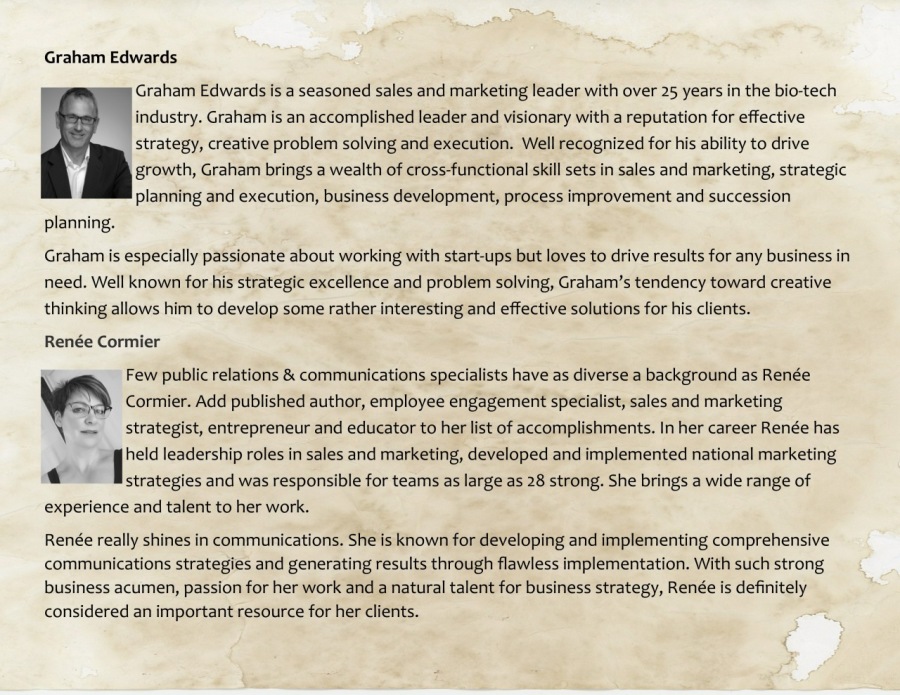Questions to Help You Mind Your Business... Question #1
A Blog Series by Graham Edwards and Renée Cormier
This is the first in a series of thoughts and opinions by Graham Edwards and Renée Cormier — click here to read the backstory and inspiration (if only for the entertainment). It should be noted that neither of us have seen or discussed our answers before they are posted, which in our mind makes this all the more interesting.
In this blog series we will attempt to answer ten different questions business owners may need answered, using our individual and unique perspectives and approaches. It is our hope that this series will inspire both action and interaction. Please feel free to comment and ask more questions.
Question #1: How can I create a fuller picture of the nature of my business?

Graham —
In my mind there is a much bigger (and more important) question hidden within this question:
”What is the nature of my business, or what is my business?”
I put this out there for no other reason than I keep asking myself, “How can you ‘create a fuller picture’ if you are not really sure what the nature of your business is?” I have now started to morph this into something that could get very big and very complicated, so let me anchor all of this with the customer — because in the end, who else would we be creating a fuller picture for?
There may be more but I have found there are four types of customers that come into the sphere of consideration for any business:
- The end user who purchases your goods or services
- The employee(s)
- The community that you are in (I also include regulators here)
- The shareholder or investor (current and future)
This now allows us to align “the customer” with what the business is, and more importantly develop language to communicate and paint a picture for the customer; this language defines the business and needs to be developed in such a way that it can be articulated easily and clearly (be it to one person or one million). There are a number of strategic vehicles that will develop the language of what the company is, as well as create the framework for strategic thinking and execution. I believe these are the four most important:
The business’ vision: the company's road map indicating what the company wants to become and the guiding transformational principles which set the company's direction. This should be developed into a written statement. *
The business’ mission: the organization’s purpose, identifying the scope of its operations: — what kind of product or service it provides, its primary customers or market, and its geographical region of operation. This should be developed into a written statement. *
The value proposition: the benefits customers get when buying a particular product or service from the business. It should convince consumers that this product or service is better than others on the market — this can lead to a differentiating value proposition*
The business plan: a formal statement of business goals, the market, reasons they are attainable, and plans and activities for reaching them. It is important to have a detailed financial perspective associated with your business plan. *
This can be all be done on a piece of paper, a 20-slide presentation or a 100-page document but in the end it is important to have it written down — getting your business down in black and white makes real, easier to communicate and minimizes creative interpretation of what the business is really all about.
- Creating a fuller picture of the nature of your business comes down to three areas:
- Understanding your customers.
- Determining your Vision, Mission, Value Proposition, and have a Business Plan.
Align (and effectively communicate) your business to the appropriate customer segment, while ensuring the core message of your business is the same no matter who the customer is.
I suppose you could argue that the more marketing channels you use to communicate your business the fuller the picture of the business will be, but then again, if the aspects of the business are unclear then really all you get is a picture of the business that is fuzzy.
And besides, having done the business plan you will have realized your marketing plan is rather limited when it comes to OPEX so you will have to get very, very creative.
Your investors will definitely appreciate that.
Iamgpe
* A little help from Wikipedia.
Renée —
Before I answer this question, I think I may need to clarify why you may want to be able to see your business from a fuller perspective. The answer is simple. We tend to miss opportunities when we don’t take the time to fully reassess our position. If you don’t want to stagnate, you need to regularly take the time to step back and realign your objectives. Interestingly, this works in both business and in day to day life.
In order to create a fuller picture of the nature of your business, you really need to understand it from every angle. I know, it’s your business and you probably feel like you know it inside out (and you most likely do), but there are things larger companies do that smaller businesses could really benefit from that allow you to see your business from a different angle. Sometimes being able to look at things from a different perspective is the best way to figure out what’s missing.
Below are some things you can do to help you get a fuller understanding of the nature of your business and hopefully kick up your results a notch.
1. Conduct a Competitive Analysis: Understanding the strengths and weaknesses of your competitors allows you to be more strategic in how you run your own business. I could write an entire blog on that, but don’t have the luxury of space in this post. This link to Edward Lowe Foundation provides you with great information on how to conduct your own competitive analysis. The information you garner about your competition from following the suggested steps will prove to be highly valuable. Trust me when I tell you that knowledge is power.
2. Conduct Market Research: Market research doesn’t have to involve hiring an expensive marketing firm to find out what your customers think. There are many inexpensive online tools and questionnaires that you can send out to anyone who has made an inquiry or purchase from you. Are you collecting customer data? You’d better start soon. That information is like gold to your business. You can’t assume your customers are getting everything they need from you, and what about the people who don’t do business with you? Why are they taking their business elsewhere? Inquiring minds want to know.
3. Develop Customer Profiles/ Buyer Personas: Use the information from your market research to develop buyer personas. A “who, what, when where, why and how” approach will help you paint a very clear picture of who your customers are and give you the chance to really see where you are missing out. I recently wrote a post about buyer personas on beBee. Here’s the link.
4. Conduct a SWOT Analysis: The best way to get a 360 degree view of your business is to start with a SWOT analysis. SWOT, is an acronym for strengths, weaknesses, opportunities and threats. Provide as much information about your business as you can under each heading. Use the information you gather from your competitive analysis and market research to help you understand more about your business.
5. Understand Your Unique Selling Proposition (USP): All businesses sell something and many businesses offer the same products and services, so you need to figure out what makes you unique. Some companies will use price as their USP, but that isn’t always the draw for customers. Let’s face it, sometimes you don’t want to be the cheapest alternative in your industry, either. Your USP could be your return policy, your stellar customer service, quality product, or any number of things. You may already believe you know what your USP is, and you could be exactly right, but you could also be completely wrong. Use your market research to figure out what your customers like the most about you. If it turns out to be different from what you’ve been telling everyone, you may discover you have an even bigger opportunity in front of you.
Once you’ve assembled all this great information about your business you can identify a specific business objective. Clarity has a way of inspiring action and producing better results. In one of our upcoming posts we will be discussing the importance of planning. Stay tuned…
Thanks to the social media platform beBee, Renée Cormier & Graham Edwards developed a business relationship and friendship that typically involves regular meetings, goal setting sessions, etc. Our meetings often provide the fuel for plans around business strategy, blog ideas and more.

""
Articles from Graham🐝 Edwards
View blog
In my part of the world the COVID-19 pandemic has become manageable and the normality of working alo ...
Recently I thought I had reached a level of wisdom that I could offer thoughts on a number of things ...

This timeline may not be particularly accurate, but I believe it’s directionally sound and I’m almos ...
Related professionals
You may be interested in these jobs
-
food service supervisor
Found in: Talent CA 2 C2 - 4 days ago
Pizza Hut Toronto, CanadaEducation: Secondary (high) school graduation certificate · Experience: 1 year to less than 2 years · Tasks · Establish methods to meet work schedules · Supervise and co-ordinate activities of staff who prepare and portion food · Train staff in job duties, sanitation and safety p ...
-

Quality
Found in: Jooble CA O C2 - 2 days ago
Ramboll Group A/S Vancouver, BC, CanadaApplicants must be currently authorized to work in the United States on a full-time basis. We invite you to bring your Air Quality and Business Development skills into play as you contribute to innovative and sustainable air quality solutions to help us grow our Pacific Northwest ...
-

Development Scientist, Canadian Blood Services
Found in: Jooble CA O C2 - 2 days ago
Canadianhematologysociety CanadaDevelopment Scientist Canadian Blood Services · Location: Remote with travel to Vancouver, BC · Canadian Blood Services is an essential part of the country's network of healthcare systems. Together, with donors, recipients, employees, partners and volunteers, Canadian Blood Ser ...


Comments
Graham🐝 Edwards
6 years ago #5
Thanks for the comment Jerry Fletcher and your insight into the Ps.... I really like it (as well as the video). Thanks for sharing!
Graham🐝 Edwards
6 years ago #4
Thanks for the comment Don \ud83d\udc1d Kerr... I had not of PEST and now I have... thx
Jerry Fletcher
6 years ago #3
don kerr
6 years ago #2
Graham🐝 Edwards
6 years ago #1